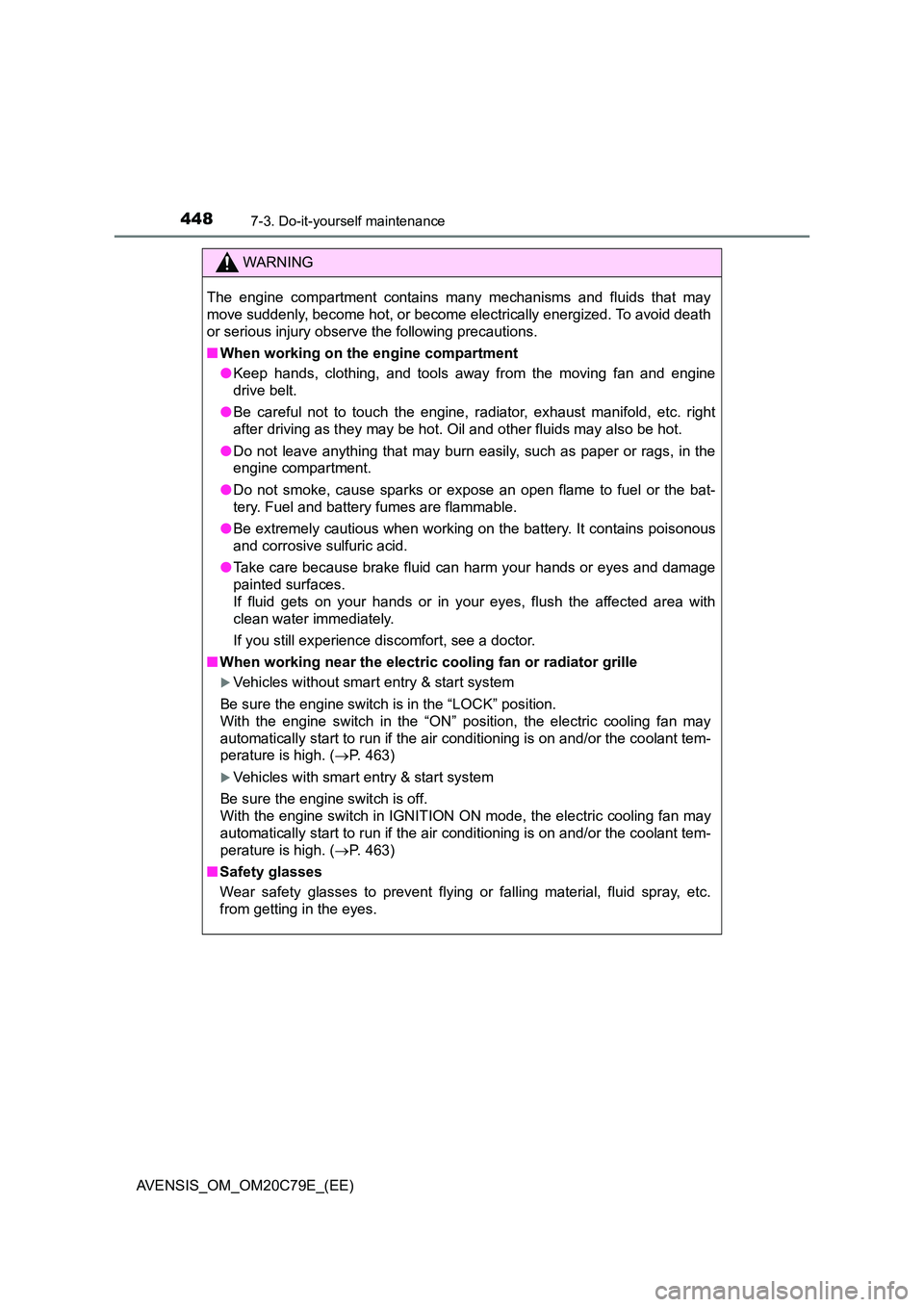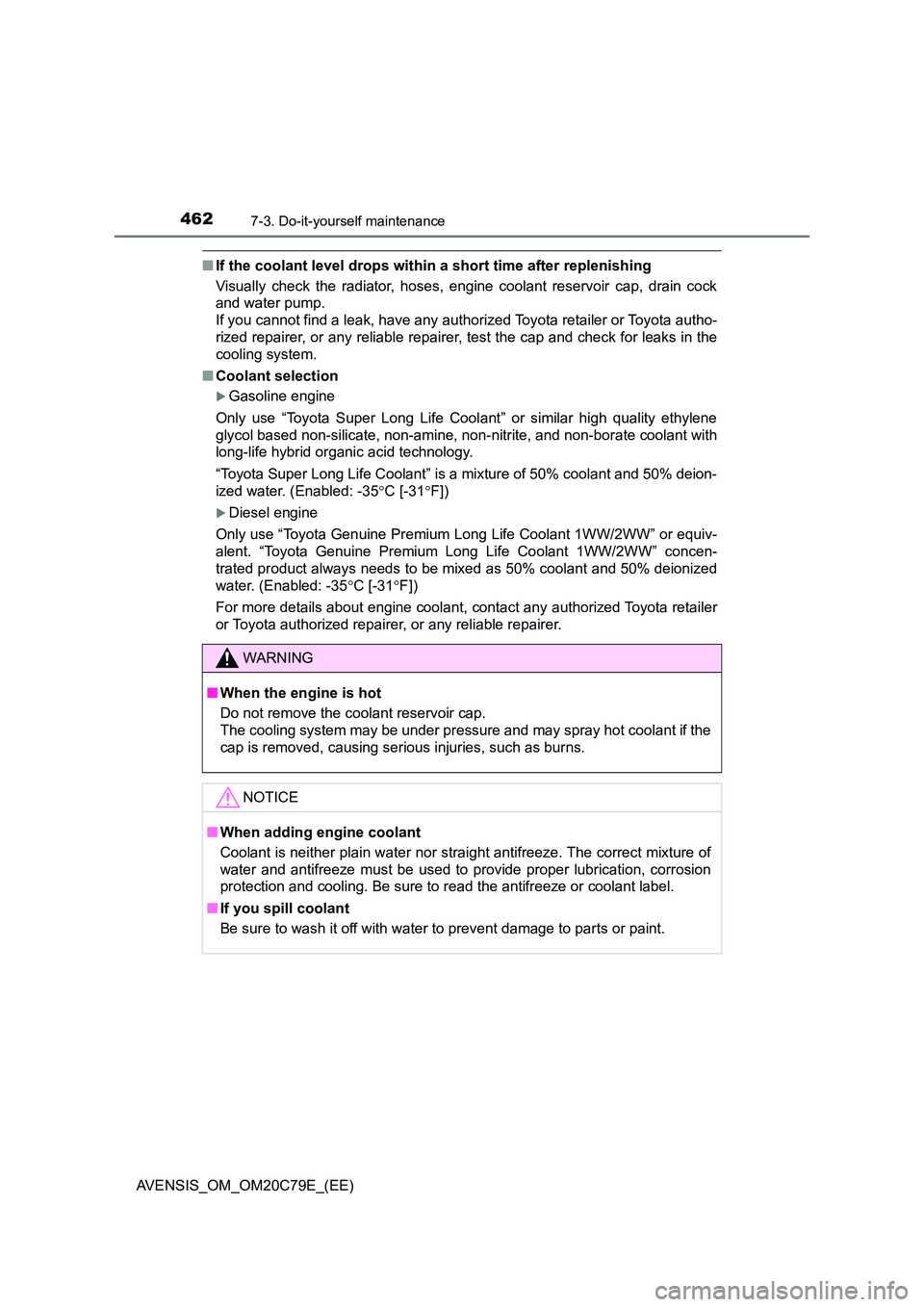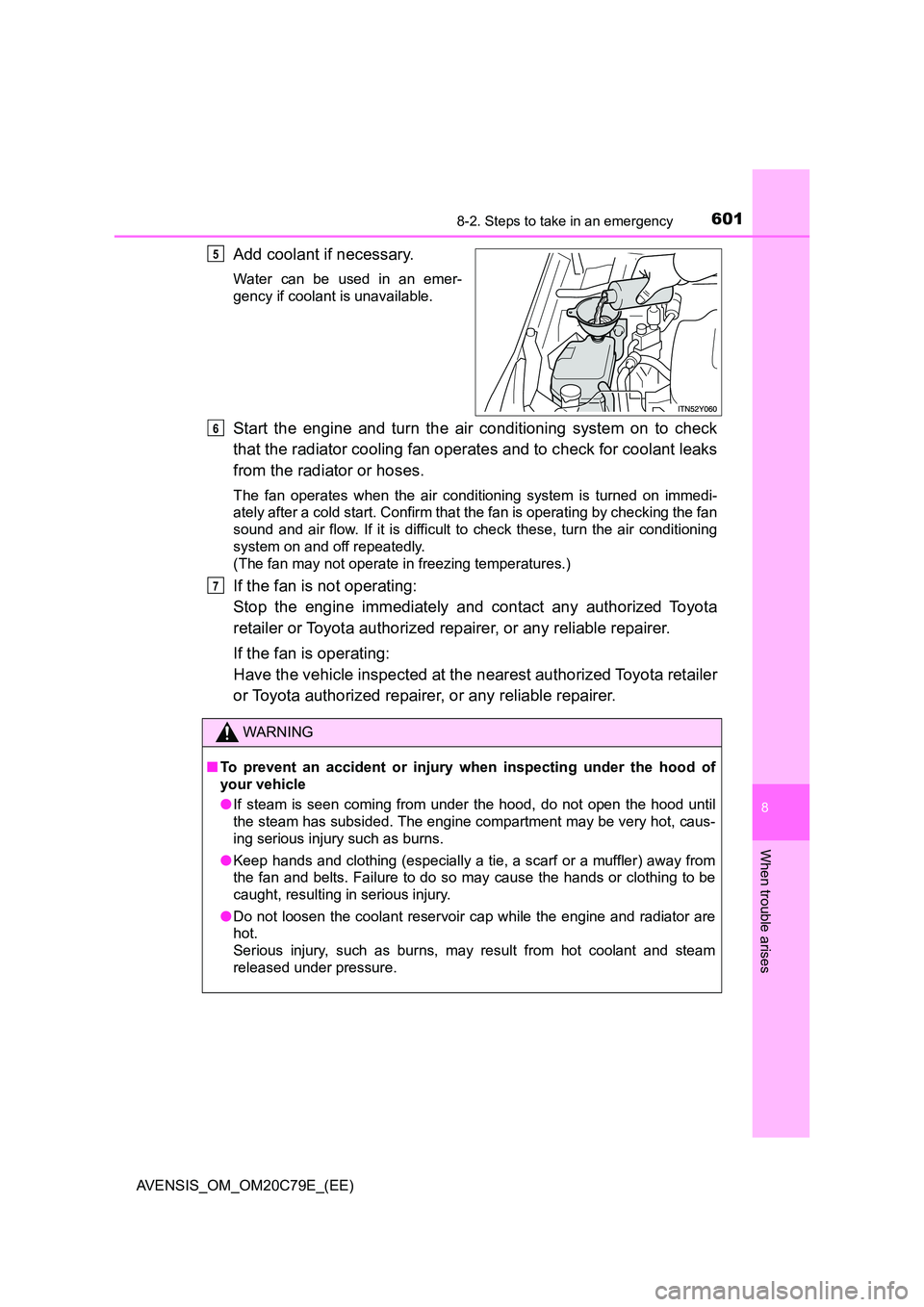Page 447 of 660
4477-3. Do-it-yourself maintenance
AVENSIS_OM_OM20C79E_(EE)
7
Maintenance and care
Light bulbs
(P. 501)
• Bulb with same number and wattage rating as origi-
nal
• Phillips-head screwdriver
• Flathead screwdriver
• Wrench
Radiator,
condenser and
intercooler
(P. 463)
Tire inflation
pressure
(P. 486)
• Tire pressure gauge• Compressed air source
Washer fluid
(P. 466)• Water or washer fluid containing antifreeze (for win-
ter use)
• Funnel
ItemsParts and tools
Page 448 of 660

4487-3. Do-it-yourself maintenance
AVENSIS_OM_OM20C79E_(EE)
WARNING
The engine compartment contains many mechanisms and fluids that may
move suddenly, become hot, or become el ectrically energized. To avoid death
or serious injury observe the following precautions.
■ When working on the engine compartment
● Keep hands, clothing, and tools away from the moving fan and engine
drive belt.
● Be careful not to touch the engine, radiator, exhaust manifold, etc. right
after driving as they may be hot. Oil and other fluids may also be hot.
● Do not leave anything that may burn easily, such as paper or rags, in the
engine compartment.
● Do not smoke, cause sparks or expose an open flame to fuel or the bat-
tery. Fuel and battery fumes are flammable.
● Be extremely cautious when working on the battery. It contains poisonous
and corrosive sulfuric acid.
● Take care because brake fluid can harm your hands or eyes and damage
painted surfaces.
If fluid gets on your hands or in your eyes, flush the affected area with
clean water immediately.
If you still experience discomfort, see a doctor.
■ When working near the electric cooling fan or radiator grille
Vehicles without smart entry & start system
Be sure the engine switch is in the “LOCK” position.
With the engine switch in the “ON” position, the electric cooling fan may
automatically start to run if the air conditioning is on and/or the coolant tem-
perature is high. ( P. 463)
Vehicles with smart entry & start system
Be sure the engine switch is off.
With the engine switch in IGNITION ON mode, the electric cooling fan may
automatically start to run if the air conditioning is on and/or the coolant tem-
perature is high. ( P. 463)
■ Safety glasses
Wear safety glasses to prevent flying or falling material, fluid spray, etc.
from getting in the eyes.
Page 453 of 660
4537-3. Do-it-yourself maintenance
AVENSIS_OM_OM20C79E_(EE)
7
Maintenance and care
Engine compartment
Gasoline engine
Washer fluid tank (P. 466)
Engine coolant reservoir
(P. 461)
Engine oil filler cap (P. 458)
Engine oil level dipstick
(P. 456)Battery (P. 463)
Fuse box (P. 496)
Electric cooling fan
Condenser (P. 463)
Radiator (P. 463)1
2
3
4
5
6
7
8
9
Page 454 of 660
4547-3. Do-it-yourself maintenance
AVENSIS_OM_OM20C79E_(EE)
Diesel engine
Washer fluid tank (P. 466)
Engine coolant reservoir
(P. 461)
Engine oil filler cap (P. 458)
Engine oil level dipstick
(P. 456)
Fuel filter (P. 467)Fuse box (P. 496)
Battery (P. 463)
Electric cooling fans
Condenser (P. 463)
Intercooler (P. 463)
Radiator (P. 463)1
2
3
4
5
6
7
8
9
10
11
Page 462 of 660

4627-3. Do-it-yourself maintenance
AVENSIS_OM_OM20C79E_(EE)
■If the coolant level drops within a short time after replenishing
Visually check the radiator, hoses, engine coolant reservoir cap, drain cock
and water pump.
If you cannot find a leak, have any authorized Toyota retailer or Toyota autho-
rized repairer, or any reliable repairer, test the cap and check for leaks in the
cooling system.
■ Coolant selection
Gasoline engine
Only use “Toyota Super Long Life Cool ant” or similar high quality ethylene
glycol based non-silicate, non-amine, non- nitrite, and non-borate coolant with
long-life hybrid organic acid technology.
“Toyota Super Long Life Coolant” is a mixture of 50% coolant and 50% deion-
ized water. (Enabled: -35 C [-31F])
Diesel engine
Only use “Toyota Genuine Premium Long Life Coolant 1WW/2WW” or equiv-
alent. “Toyota Genuine Premium Long Life Coolant 1WW/2WW” concen-
trated product always needs to be mixed as 50% coolant and 50% deionized
water. (Enabled: -35 C [-31F])
For more details about engine coolant, contact any authorized Toyota retailer
or Toyota authorized repairer, or any reliable repairer.
WARNING
■ When the engine is hot
Do not remove the coolant reservoir cap.
The cooling system may be under pressure and may spray hot coolant if the
cap is removed, causing serious injuries, such as burns.
NOTICE
■ When adding engine coolant
Coolant is neither plain water nor straight antifreeze. The correct mixture of
water and antifreeze must be used to provide proper lubrication, corrosion
protection and cooling. Be sure to read the antifreeze or coolant label.
■ If you spill coolant
Be sure to wash it off with water to prevent damage to parts or paint.
Page 463 of 660
4637-3. Do-it-yourself maintenance
AVENSIS_OM_OM20C79E_(EE)
7
Maintenance and care
Check the radiator, condenser and intercooler (diesel engine) and
clear any foreign objects.
If any of the above parts are extremely dirty or you are not sure of
their condition, have your vehicle checked by any authorized Toyota
retailer or Toyota authorized repairer, or any reliable repairer.
Check the battery as follows.
■Caution symbol
The meanings of each caution symbol on the top of the battery are
as follows:
Radiator, condenser and intercooler
WARNING
■ When the engine is hot
Do not touch the radiator, condenser or intercooler, as they may be hot and
cause serious injuries, such as burns.
Battery
No smoking, no naked
flames, no sparksBattery acid
Shield eyesNote operating
instructions
Keep away from chil-
drenExplosive gas
Page 600 of 660

6008-2. Steps to take in an emergency
AVENSIS_OM_OM20C79E_(EE)
If your vehicle overheats
Stop the vehicle in a safe place and turn off the air conditioning sys-
tem, and then stop the engine.
If you see steam:
Carefully lift the hood after the steam subsides.
If you do not see steam:
Carefully lift the hood.
After the engine has cooled down sufficiently, inspect the hoses and
radiator core (radiator) for any leaks.
Radiator
Cooling fan
If a large amount of coolant
leaks, immediately contact any
authorized Toyota retailer or
Toyota authorized repairer, or
any reliable repairer.
The coolant level is satisfactory if it is between the “FULL” and
“LOW ” lines on the reservoir.
Reservoir
“FULL” line
“LOW ” line
The following may indicate that your vehicle is overheating.
● The engine coolant temperature gauge (P. 104) enters the red
zone or a loss of power is experienced. (For example, the vehicle
speed does not increase.)
● Steam comes out from under the hood.
Correction procedures
1
2
3
1
2
4
1
2
3
Page 601 of 660

6018-2. Steps to take in an emergency
AVENSIS_OM_OM20C79E_(EE)
8
When trouble arises
Add coolant if necessary.
Water can be used in an emer-
gency if coolant is unavailable.
Start the engine and turn the air conditioning system on to check
that the radiator cooling fan operates and to check for coolant leaks
from the radiator or hoses.
The fan operates when the air conditioning system is turned on immedi-
ately after a cold start. Confirm that the fan is operating by checking the fan
sound and air flow. If it is difficult to check these, turn the air conditioning
system on and off repeatedly.
(The fan may not operate in freezing temperatures.)
If the fan is not operating:
Stop the engine immediately and contact any authorized Toyota
retailer or Toyota authorized repairer, or any reliable repairer.
If the fan is operating:
Have the vehicle inspected at the nearest authorized Toyota retailer
or Toyota authorized repairer, or any reliable repairer.
5
WARNING
■ To prevent an accident or injury when inspecting under the hood of
your vehicle
● If steam is seen coming from under the hood, do not open the hood until
the steam has subsided. The engine compartment may be very hot, caus-
ing serious injury such as burns.
● Keep hands and clothing (especially a tie, a scarf or a muffler) away from
the fan and belts. Failure to do so may cause the hands or clothing to be
caught, resulting in serious injury.
● Do not loosen the coolant reservoir cap while the engine and radiator are
hot.
Serious injury, such as burns, may result from hot coolant and steam
released under pressure.
6
7